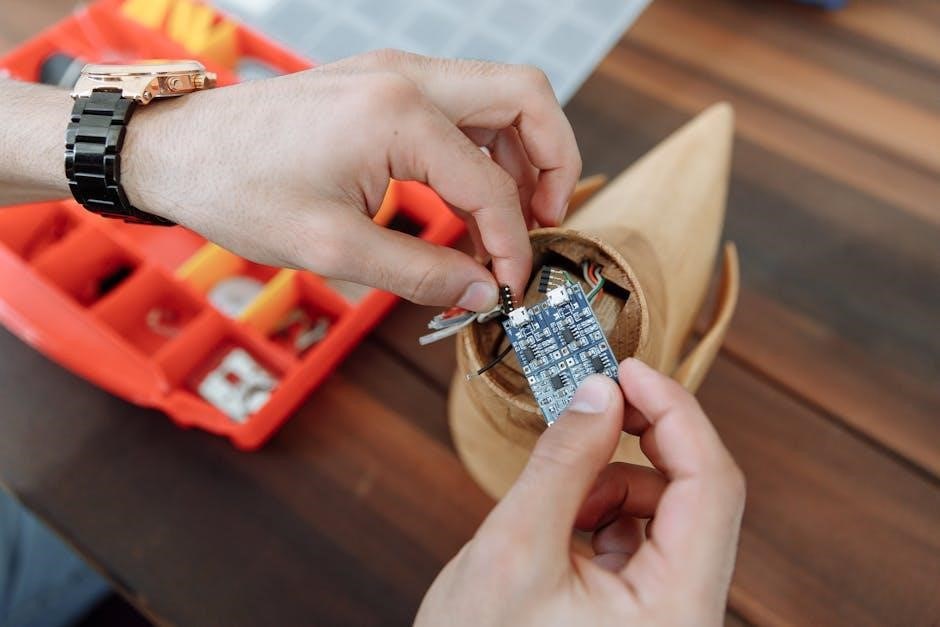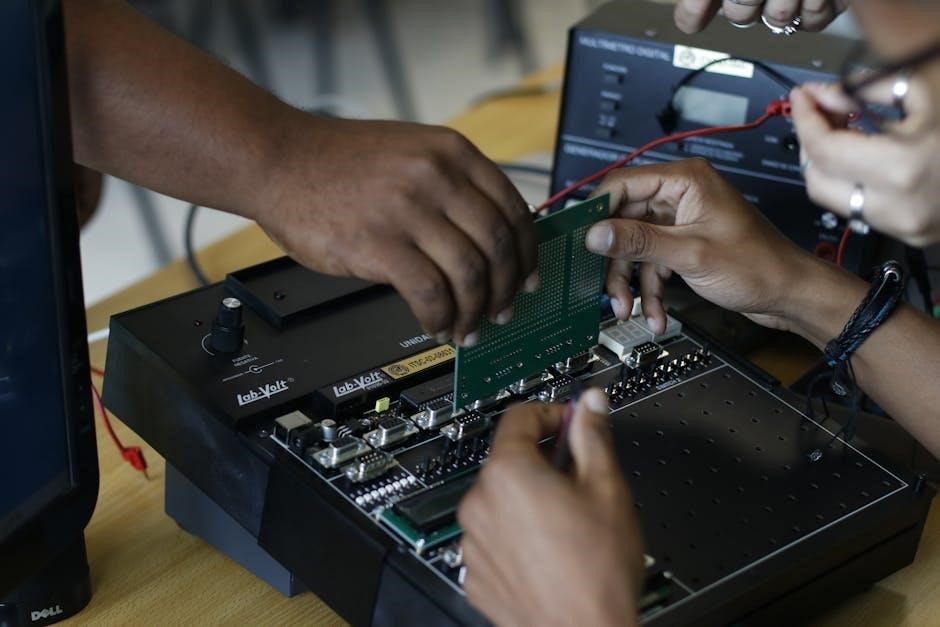Welcome to the DSC Neo Programming Manual‚ your comprehensive guide to configuring and optimizing the DSC Neo security system. This manual is designed to assist both novice and experienced users in understanding the system’s features‚ performing installations‚ and troubleshooting common issues. Whether you’re setting up zones‚ managing access codes‚ or exploring advanced programming options‚ this manual provides detailed instructions to ensure seamless operation. Follow the step-by-step guides to unlock the full potential of your DSC Neo system and enhance your security setup.
Overview of the DSC Neo Security System
The DSC Neo is a hybrid security system that supports both hardwired and wireless devices‚ offering flexibility and scalability for residential and commercial applications. It features advanced programming options‚ including zone configuration‚ user code management‚ and remote access capabilities. Designed for ease of use‚ the system offers a user-friendly interface through its keypads and remote platforms. With robust security features and reliable performance‚ the DSC Neo is a versatile solution for modern security needs‚ ensuring comprehensive protection and peace of mind.
Key Features and Benefits of the DSC Neo System
The DSC Neo system offers a hybrid approach‚ supporting both hardwired and wireless devices for flexible installation. It features advanced programming options‚ including zone configuration‚ user code management‚ and remote access. The system supports multiple keypads‚ such as the HS2LCDRF‚ and integrates seamlessly with keyfobs for enhanced convenience. With scalable design‚ the Neo system can adapt to various security needs‚ from residential to commercial settings. Its robust security features‚ combined with user-friendly interfaces‚ make it a reliable and versatile choice for modern security solutions.
Importance of Proper Programming for System Efficiency

Proper programming is essential for maximizing the efficiency and functionality of the DSC Neo system. Accurate configuration ensures all components operate seamlessly‚ reducing errors and enhancing security. Misprogramming can lead to system malfunctions‚ false alarms‚ or vulnerabilities. Referencing the official manual and following structured programming workflows helps avoid common pitfalls. Regular updates and adherence to manufacturer guidelines maintain optimal performance‚ ensuring the system meets safety standards and user expectations effectively.

Getting Started with DSC Neo Programming
Getting started with DSC Neo programming requires reviewing system requirements and compatibility. Download the official manual for detailed instructions and diagrams. Ensure you have the necessary tools and equipment for a smooth setup. Familiarize yourself with the keypad layout and basic functions to begin programming effectively.
System Requirements and Compatibility
The DSC Neo system is compatible with a range of hardware‚ including HS2016‚ HS2032‚ HS2064‚ and HS2128 control panels. Ensure your system meets the minimum software version requirements for optimal performance. The Neo system supports both hardwired and wireless zones‚ offering flexibility for various installations. Compatibility extends to remote access tools‚ requiring specific communication modules like GSM or IP. Verify operating system compatibility for remote monitoring and control. Always check the official manual for detailed specifications and compatibility charts to ensure seamless integration with your security setup.
Downloading and Referencing the Official Manual
The official DSC Neo programming manual is available for download from the DSC website or trusted sources like ManualsLib. Visit the DSC website‚ navigate to the support section‚ and search for the PowerSeries Neo manual. Ensure you download the correct version for your system. The manual provides detailed instructions for installation‚ configuration‚ and troubleshooting. Reference it regularly to understand advanced features‚ zone setup‚ and programming options. Save a digital copy for easy access and use it as your primary guide for optimal system performance and maintenance.
Basic Tools and Equipment Needed for Programming
To program the DSC Neo system‚ you’ll need a few essential tools. Start with the system’s keypad‚ as it provides direct access to the programming menu. Ensure you have the installer code‚ typically found in the official manual or provided by the installer. A computer with internet access is necessary for downloading the latest software updates or reference materials. Additionally‚ a USB cable may be required for firmware updates. Optional tools include a screwdriver for accessing the control panel and a label maker for organizing zones and user codes. Having these tools ready ensures a smooth programming experience.

Understanding the Control Panel
The control panel is the central hub of the DSC Neo system‚ featuring a keypad‚ display screen‚ and navigation buttons for easy system operation and programming access.
Layout and Functionality of the Keypad
The DSC Neo keypad is a user-friendly interface designed for easy navigation and control. Available in LCD or ICON versions‚ it features numbered keys for zone labels and function keys for quick actions. Navigation buttons like ‘*’ and ‘#’ simplify menu access. Status indicators provide real-time feedback on system conditions. This layout ensures intuitive operation‚ making it easy to arm/disarm the system‚ access programming‚ and monitor security status.
Navigating the Programming Menu
Navigating the DSC Neo programming menu is straightforward once familiar with the key commands. Press ‘*’ to enter programming mode‚ followed by the installer code. Use numbered keys to select specific sections‚ such as zone configuration or user management. The ‘#’ key allows you to toggle options‚ while ‘OK’ confirms selections. Arrows or navigation keys simplify scrolling through menus. Refer to the reference manual for detailed descriptions of each section and option to ensure accurate configurations. Proper navigation ensures efficient system setup and customization.
Installer Code and User Code Management
The DSC Neo system requires an installer code for advanced programming and a user code for basic operations. The default installer code is typically ‘4321‚’ but it’s recommended to change it for security. User codes can be created for multiple users‚ with options to assign varying access levels. Codes can be programmed by accessing the user configuration section via the keypad. Ensure codes are kept secure and updated regularly. Keyfobs can also be linked to user codes for convenient access. Always avoid using default codes to maintain system security.

Zone Configuration and Setup
Zone configuration is crucial for tailored security. Define zones‚ assign numbers‚ and set labels to customize your system. Refer to the manual for detailed steps.
Types of Zones (Hardwired vs. Wireless)
The DSC Neo system supports both hardwired and wireless zones‚ offering flexibility in security setup. Hardwired zones are directly connected to the control panel‚ ensuring reliable performance and minimal interference. Wireless zones‚ however‚ provide ease of installation and adaptability‚ ideal for areas where wiring is challenging. Both options allow for precise customization‚ enabling users to tailor their security configuration to specific needs. Understanding the differences helps in optimizing system performance and ensuring comprehensive protection for your premises.
Assigning Zone Numbers and Labels
Assigning zone numbers and labels is crucial for organizing and monitoring your DSC Neo system effectively. Each zone should be given a unique number‚ typically starting from 1‚ to avoid conflicts. Labels provide descriptive names for each zone‚ making it easier to identify areas like “Front Door” or “Living Room Window.” Access the programming menu‚ enter the installer code‚ and navigate to zone configuration. Assign numbers sequentially and labels descriptively for clarity. This ensures quick identification and efficient system management‚ enhancing overall security monitoring and response. Proper labeling also aids in troubleshooting and maintenance tasks. Consistency is key to maintaining an organized and functional security setup. Regularly review and update zone labels as needed to reflect any changes in your premises layout or security requirements. This step ensures that your system remains intuitive and responsive‚ providing reliable protection for your property. By carefully assigning zone numbers and labels‚ you can optimize your DSC Neo system’s performance and user experience. This process is foundational for advanced configurations and ensures seamless integration of all security components. Clear zone identification simplifies arming‚ disarming‚ and responding to alerts‚ making it an essential part of your system’s setup. Invest time in this step to reap long-term benefits in security management and ease of use. Your DSC Neo system will operate more efficiently with well-organized zones‚ contributing to a safer and more secure environment. Proper zone labeling also helps in training new users and ensures that everyone understands the system layout. This consistency reduces errors and enhances overall security effectiveness. By following these guidelines‚ you can create a robust and user-friendly security system tailored to your specific needs. Regular updates to zone labels maintain system accuracy and adaptability‚ ensuring your security setup remains effective over time. This attention to detail is vital for maximizing the potential of your DSC Neo system and safeguarding your property.
Configuring Zone-Specific Settings and Options
Configuring zone-specific settings allows you to customize how each zone in your DSC Neo system operates. Hardwired zones can be set for normally closed (NC) or normally open (NO) configurations‚ while wireless zones are configured based on device type. Options include bypassing zones‚ enabling alarm triggers‚ and setting entry/exit delays. Advanced settings like zone sensitivity‚ tamper detection‚ and low-battery alerts can also be adjusted. Access these settings through the programming menu by entering the installer code and selecting the desired zone. Regularly review and update zone configurations to ensure optimal performance and security. Proper configuration enhances system reliability and user experience.

Access Codes and User Management
Access codes and user management are critical for securing your DSC Neo system. Manage user codes‚ assign permissions‚ and ensure secure access to maintain system integrity and control.
Creating and Managing User Codes

Creating and managing user codes is essential for securing your DSC Neo system. Enter the installer code to access programming mode‚ then navigate to the user code section. Assign unique codes to each user‚ ensuring they are easy to remember but secure. Codes can be 4-6 digits long and should be shared responsibly. Use the keypad to add‚ modify‚ or delete codes‚ and assign access levels to restrict or grant permissions. For advanced setups‚ integrate keyfobs with user codes for seamless access control. Regularly update codes to maintain system security and prevent unauthorized access.
Assigning Access Levels and Permissions
Assigning access levels and permissions ensures users have appropriate system access. Enter installer programming mode and navigate to the user management section. Select the desired user code and choose from predefined access levels‚ such as Administrator‚ Manager‚ or Basic User. Administrators can perform advanced tasks‚ while Basic Users can only arm/disarm the system. Customize permissions to restrict or allow access to specific zones‚ event logs‚ or system settings. This feature enhances security by limiting unauthorized access to sensitive functions. Use the keypad to save changes and ensure only authorized users have elevated privileges.
Keyfob Integration and Configuration
Keyfob integration enhances system convenience‚ allowing users to arm‚ disarm‚ and trigger specific outputs wirelessly. To configure a keyfob‚ enter programming mode and navigate to the user configuration section. Assign the keyfob to a user code by selecting the appropriate keypad number. Each keyfob button can be programmed for specific functions‚ such as arming/disarming or triggering PGM outputs. Ensure the keyfob is enrolled correctly by following the manual’s enrollment process. This feature provides users with seamless control over their security system‚ improving accessibility and ease of use. Refer to the manual for detailed enrollment instructions.

Advanced Programming Features
Explore system timers‚ PGM outputs‚ and remote access configurations to enhance functionality. These features allow for custom settings‚ offering scalability and adaptability to meet specific security needs effectively.
System Timers and Schedules
System timers and schedules in the DSC Neo allow for automated control of security settings. Program timers to control arming‚ disarming‚ and specific system responses. Use schedules to automate routines‚ such as locking doors or activating lights. Access these features via the installer programming menu by entering the installer code and navigating to the timer section. Configure exit delays‚ entry delays‚ and other timing options to customize system behavior. These settings enhance convenience and security‚ ensuring your system operates efficiently. Refer to the official manual for detailed instructions on configuring timers and schedules effectively.
PGM Programming and Output Configurations
PGM (Programmable Output Module) programming allows you to customize system responses to specific events. Configure PGM outputs to control external devices like lights or locks. Access the PGM menu by entering the installer code and selecting the appropriate section. Assign PGM outputs to trigger during alarms‚ arming/disarming‚ or custom events. Use the keypad to enable or disable outputs and set delays or durations. This feature enhances system flexibility‚ enabling tailored security solutions. Refer to the manual for detailed PGM configuration steps and output options to maximize your system’s functionality.
Remote Access and Communication Settings
Remote access and communication settings enable you to monitor and control your DSC Neo system from anywhere. Configure remote monitoring through compatible software or apps. Set up IP communication by entering the server IP address‚ port number‚ and enabling encryption. Ensure reliable connectivity by testing communication paths. Remote access allows arming/disarming‚ receiving notifications‚ and viewing system status. Refer to the manual for specific setup instructions and troubleshooting tips to ensure secure and stable remote communication.

Troubleshooting and Maintenance
Identify common issues‚ perform system diagnostics‚ and run tests to ensure optimal performance. Regular maintenance and firmware updates are essential for a reliable security system operation.
Common Issues and Solutions
Common issues with the DSC Neo system include ground faults‚ keypad errors‚ and communication problems. For ground faults‚ check wiring connections and ensure proper grounding. Keypad errors often resolve by restarting the system or updating firmware. Communication issues may require reconfiguring settings or resetting the modem. Refer to the system’s diagnostic menu for error codes and detailed solutions. Regularly updating software and performing maintenance can prevent many issues. Always consult the official manual for specific troubleshooting steps tailored to your system configuration.
System Diagnostics and Error Codes
The DSC Neo system provides a diagnostic menu to identify and resolve issues. Common error codes like E01 (communication failure) or E02 (zone fault) indicate specific problems. Access diagnostics by entering the installer code and navigating to the troubleshooting section. Each error code corresponds to a detailed solution in the manual. Regular system checks can prevent issues. Ensure all devices are powered and connections are secure. Refer to the official manual for a complete list of error codes and step-by-step solutions to maintain optimal system performance and security.
Regular Maintenance and Updates
Regular maintenance ensures the DSC Neo system operates reliably. Update firmware periodically to access new features and security enhancements. Check system health‚ battery levels‚ and connection stability. Clean the keypad and ensure all wiring is secure. Refer to the manual for specific maintenance schedules. Perform routine diagnostics to identify potential issues early. Test wireless devices and review event logs for anomalies. Follow manufacturer recommendations to keep your system up-to-date and functioning optimally‚ ensuring your security setup remains robust and efficient over time.
Mastering the DSC Neo system requires careful programming and regular updates. Refer to the official manual for detailed guidance and explore manufacturer support for further assistance.

Best Practices for Optimal System Performance
For optimal performance‚ ensure regular system updates and proper zone configuration. Always reference the official manual for specific instructions. Maintain clear user permissions and test configurations after programming changes. Regularly review and update access codes to enhance security. Use manufacturer-approved tools and follow troubleshooting guides for common issues. Schedule routine maintenance to prevent system downtime. By adhering to these practices‚ you can maximize the efficiency‚ reliability‚ and security of your DSC Neo system‚ ensuring it operates at its full potential.
Referencing the Official DSC Neo Manual
The official DSC Neo manual is an essential resource for understanding system functionality and troubleshooting. It provides detailed instructions for installation‚ zone setup‚ and advanced programming features. Available online as a downloadable PDF‚ the manual includes sections on label programming‚ system timers‚ and PGM configurations. Referencing it ensures accurate configurations and helps resolve common issues. Always consult the manual for specific model requirements‚ such as the HS2016 or HS2128‚ to ensure compatibility and proper system operation. Regular updates and diagrams are included for optimal guidance.
Manufacturer Support and Customer Service
DSC provides comprehensive support for the Neo system through their official website and customer service channels. The manufacturer offers downloadable manuals‚ installation guides‚ and troubleshooting resources to ensure smooth system operation. Users can access detailed documentation‚ including the PowerSeries Neo Reference Manual‚ for advanced programming and configuration guidance. Additionally‚ DSC’s customer support team is available to address technical inquiries‚ ensuring timely assistance for any issues. Regular updates and maintenance tips are also provided to keep the system running efficiently and securely.

